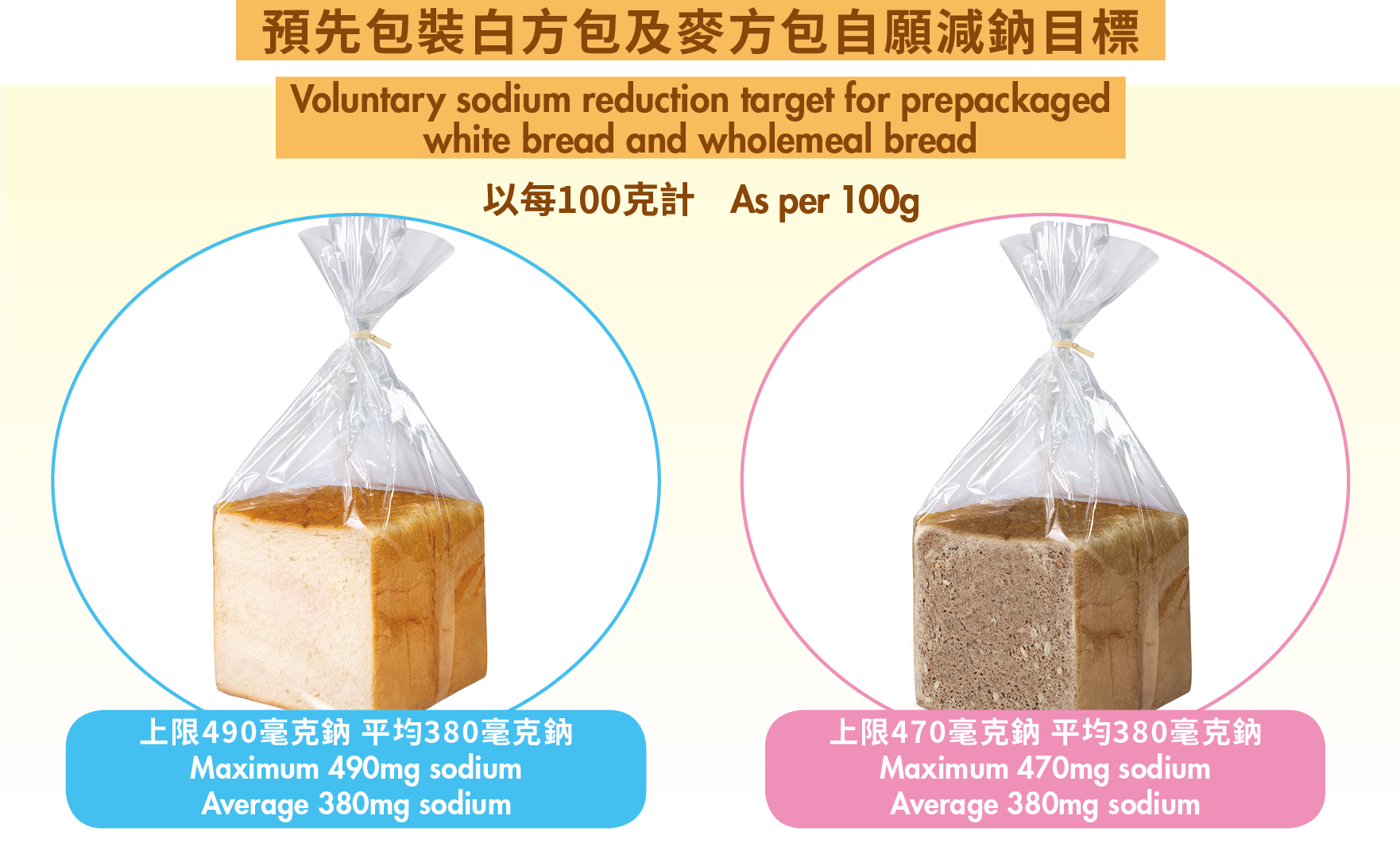
Food Safety Focus (160th Issue, November 2019) – Incident in Focus
Reduce Salt Together – Bread
Reported by Mr. Nicky HO, Scientific Officer,
Risk Communication Section, Centre for Food Safety
In bread baking, salt controls yeast growth and has a strengthening effect on the gluten in the dough. However, too much salt can lead to health problems such as hypertension, heart diseases and stroke. Consuming two slices (50g each) of white bread containing sodium content of 500mg /100g would lead to an intake 500mg of sodium, which contributes to 25% of the daily upper intake recommended by the World Health Organization (WHO).

Voluntary sodium reduction targets for prepackaged white bread and wholemeal bread (with nutrition labels)
Product Reformulation and Target Setting
In Hong Kong, according to the Population Health Survey 2014/2015 conducted by the Department of Health, persons aged 15-84 consumed 8.8g of salt (~3,520mg sodium) per day, exceeding the WHO's recommendation of salt intake of less than 5g (2,000mg sodium) per day for adult. In fact, the WHO has set up a target to reduce the global mean intake of salt by a relative 30% by 2025. Hong Kong has also adopted the same target in reducing the mean population intake of salt by 2025.
Product reformulation is considered an important pillar for salt reduction at population level. While food manufacturers are encouraged, through reformulating food products, to reduce the sodium content in food, product reformulation provides impetus for making stepwise changes to the food environment and consumer behaviours.
A recent study from the United Kingdom revealed that the sodium content of food products with sodium reduction targets set decreased more significantly over time comparing to those without any targets set. It contributes to the evidence base that a target-based approach to salt reduction can lead to reductions being made without compromising taste, quality or safety.
Sodium Content in Bread
According to a study from the Centre for Food Safety (CFS), white bread and wholemeal bread are the top two commonly consumed bread types respectively in Hong Kong.
Another study from the CFS found relatively high sodium contents in both white bread and wholemeal bread. The sodium intake can be exacerbated should the white bread be served with other high sodium fillings such as sausage and ham. This study also showed wide variations in the sodium content among certain bread types, including white bread and wholemeal bread. While salt is technically necessary in baking, such finding reflects room for the trade to cut down the sodium content in their bread products. Although salt reduction in bread may lead to changes in taste and texture, some trade members expressed willingness to reduce the amount of salt used in their bread products.
Voluntary Sodium Reduction Targets for White Bread and Wholemeal Bread
By making reference to the WHO's recommendations and overseas experiences, along with discussion with trade members, the CFS has set out voluntary sodium reduction targets for prepackaged white bread and wholemeal bread (with nutrition labels), using the results of the CFS' study as the baseline. The prepackaged bread was first chosen for target setting as consumers can easily check the sodium content from the nutrition label.
The average voluntary sodium reduction targets were agreed by reducing the average sodium content of the corresponding bread type in the CFS’ study by 10%. While the maximum voluntary sodium targets were set at the 90 percentile of the sodium content distribution of the bread type. The CFS will conduct market surveys to monitor the progress of sodium reduction by trade members.
The voluntary sodium reduction targets are planned to be lowered progressively in the future. In addition, based on the experience from the prepackaged white bread and wholemeal bread, the CFS may consider extending the targets to non-prepackaged white bread and wholemeal bread and other food products.
Salt Reduction Scheme
Following the establishment of voluntary sodium reduction targets, the CFS has launched the Salt Reduction Scheme. A number of major chained bakery shops and manufacturers have already participated in the Scheme, striving to reduce the sodium content in food products in accordance with the targets.
Key Points to Note:
- Setting sodium reduction targets is an effective approach to lower the sodium content in food products.
- The CFS has set out voluntary sodium reduction targets for prepackaged white bread and wholemeal bread (with nutrition labels).
- Reduction of salt intake in our population requires the collaboration between the Government, the food trade and consumers.
Advice to Consumers
- Maintain a balanced and varied diet. Reduce the consumption of food high in sodium.
- Use nutrition labels to choose prepackaged food including white bread and wholemeal bread with a lower sodium content.
Advice to the Trade
- Reduce the sodium content in food through product reformulation.
- Bakery shops and manufacturers can reduce the sodium content in white bread and wholemeal bread, meeting the voluntary sodium reduction targets set.

